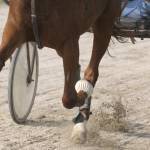Detecting and Preventing Lameness in Horses

Novel technologies, such as Kentucky Equine Research’s ClockIt smartphone app to fine-tune conditioning and the dynamic endoscope to diagnose upper airway issues during exercise, make life with horses easier. For pinpointing subtle lameness in horses—a frequently encountered problem in a large number of athletic horses—researchers are now working on using body-mounted inertial sensors to identify asymmetry*.
“Trauma and disease that cause lameness are the most common medical problems in horses,” wrote the researchers, adding that early diagnosis of lameness by assessing the horse at all gaits routinely used by that horse would be beneficial.
Analyzing the trot for soundness is easier than using other gaits because it is a symmetrical, two-beat gait. In contrast, the canter and gallop are asymmetric three- and four-beat gaits, respectively. Currently, no objective methods of assessing lameness at these higher speeds exist.
Taking steps towards facilitating lameness diagnosis in horses, Lopes and colleagues evaluated the utility of a body-mounted inertial sensor system. Six separate sensors that measured acceleration and served as gyroscopes were placed on the head, pelvis, and each limb. Acceleration and rotation of the head and pelvis, limb contact intervals, stride duration, and lead preference were all measured before and after induction of lameness.
Unfortunately, the data did not support the use of this system for evaluating lameness in galloping horses. That said, the authors relayed that this research is in its infancy and many confounding factors likely impacted the results. Tweaking the study design could ultimately prove the value of either this or a similar system.
“In the meantime, owners and trainers are encouraged to take a multimodal approach to maximizing joint health. Consider supplementing a horse’s diet with a quality oral joint health product, preferably before the onset of lameness,” advised Catherine Whitehouse, M.S., a nutrition advisor at Kentucky Equine Research (KER).
KER formulated two specific joint supplements: KER•Flex and Synovate HA. Don’t forget that omega-3 fatty acids, including DHA and EPA, as found in EO•3, are also beneficial for joint health.
In Australia, horse owners should look for Glucos-A-Flex.
*Lopes, M.A.F., A.C.O. Dearo, S.K. Reed, et al. 2016. An attempt to detect lameness in galloping horses by use of body-mounted inertial sensors. American Journal of Veterinary Research. 77(10)1121-1131.








